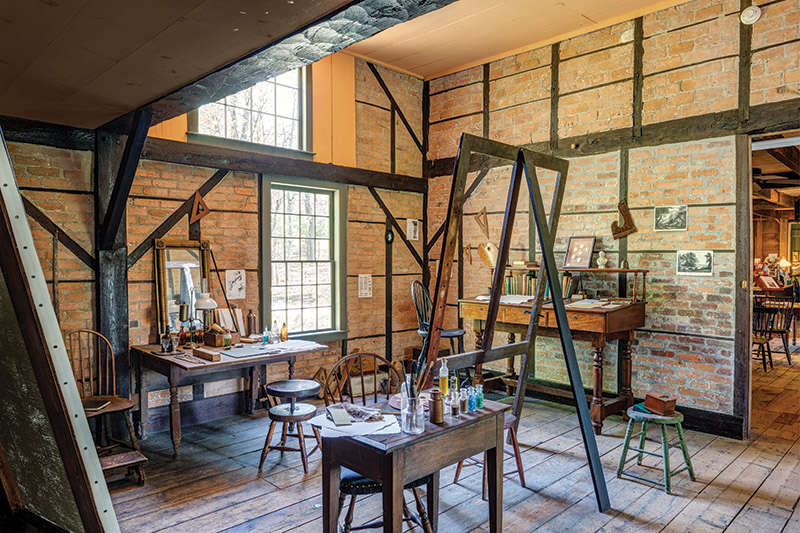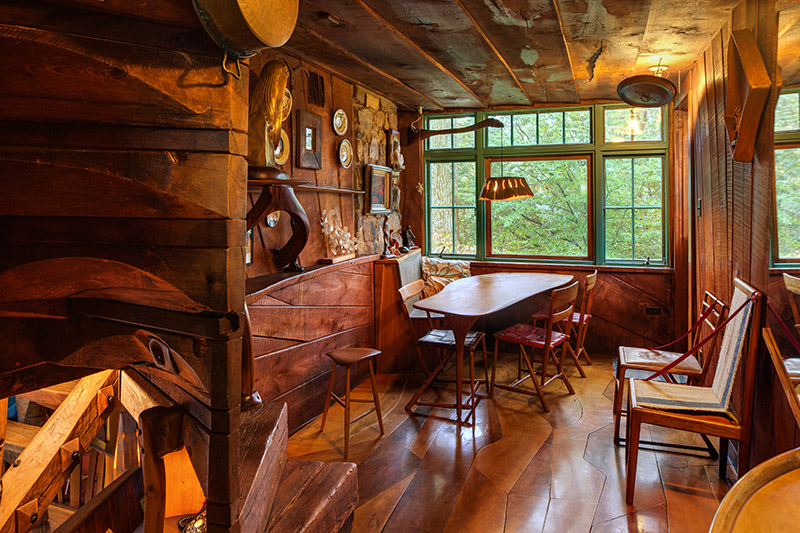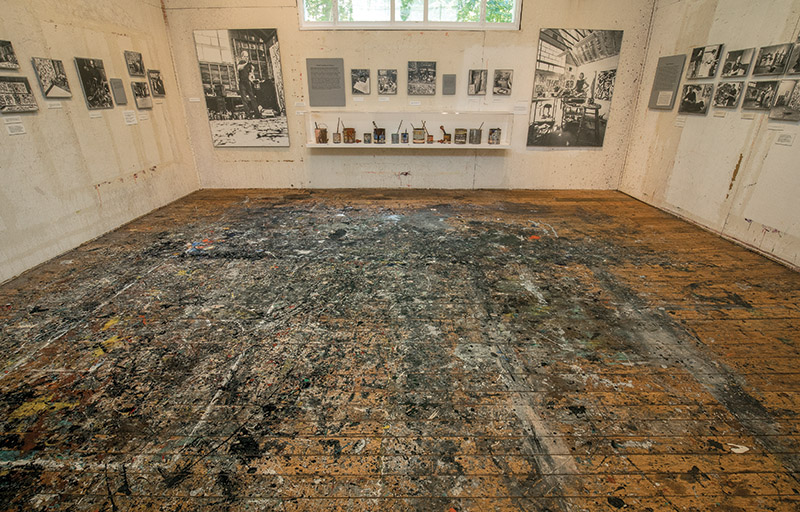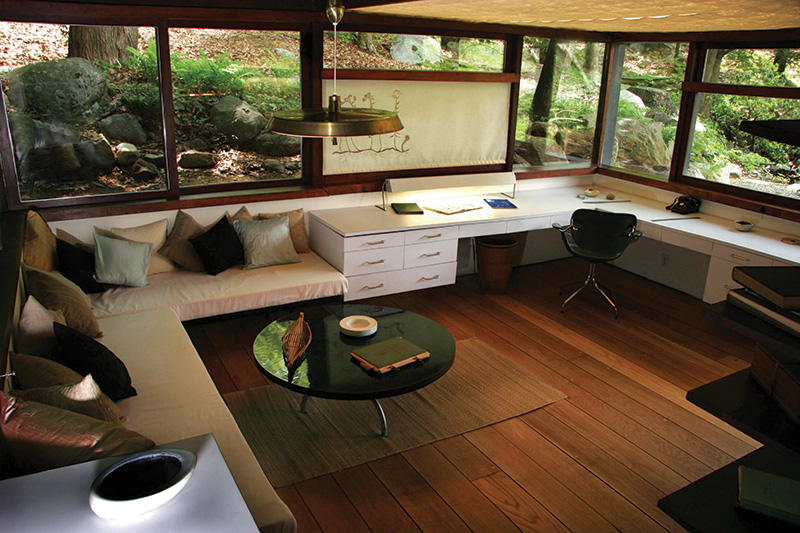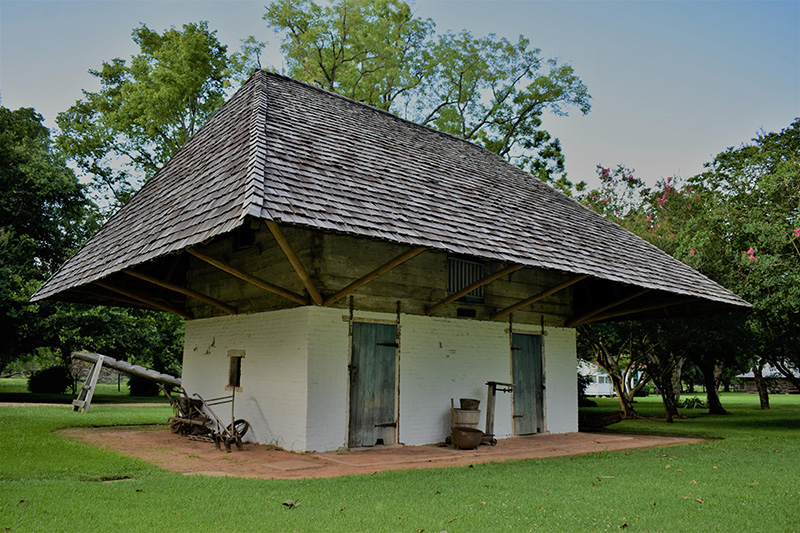Guide to Historic Artists’ Homes & Studios
by Taryn Clary
Witness creativity. That is the motto and directive of the Historic Artists’ Homes & Studios (HAHS), a network of 44 sites that preserve and interpret the homes and working environments of artists across the United States. From the New York estate of Hudson River School painter Thomas Cole (figure 1), to the Alta Loma residence of furniture designer Sam Maloof (figure 2), these sites can be found in 21 states, representing over 300 artists and spanning three centuries of American art history. Unfortunately, the startling arrival of a global pandemic abruptly made visiting the unique settings unfeasible, but almost serendipitously, an alternative access point presented itself at the same time: the publication of the Guide to Historic Artists’ Homes & Studios, authored by program manager Valerie A. Balint (Princeton Architectural Press). Conceived as an easily accessible and visually-forward guide, the book provides exactly the type of armchair travel we craved in 2020, and gives us a bounty of road trips to prepare for as these museums gradually reopen.
Approaching the content and look of the publication, Balint asked, “What can we give in this book that you can’t get elsewhere?” Having previously served as the Interim Director of Collections and Research for The Olana Partnership, the hilltop retreat of Frederic Edwin Church (figure 3), Balint had an intimate appreciation for what HAHS sites had to offer when she joined the organization in 2017. Many of the affiliated artists had already been the subject of scholarly monographs, and several sites had been featured in heftier coffee table books on architecture and landscape design. The fresh perspective this guide offers is exactly what first inspired the National Trust for Historic Preservation to establish the coalition back in 1999: the power of place. Drawing on her own understanding of how these buildings and scenery fostered the imagination of their residents and present-day visitors, Balint aspired to “convey part of what it means to be at a place; to learn about the person, their personality, the physical environment, and a little bit of the history and art; and to try to jumble that all up into a narrative.”
Organized by region, the guidebook certainly accomplishes this goal. Each site is succinctly distilled into a short essay that weaves together the biography of the artist, the history of the architecture, and the significance of the landscape to their practice. These are accompanied by a handful of images that walk you through the very best interior and exterior views; flipping through the grand vistas and ornately decorated salons, it is immediately apparent why Balint considered culling the final number of images one of the biggest challenges. The cohesion of the collection is apparent, but each narrative also stands alone in such a way that the book lends itself to a choose-your-own-adventure format: “you could read it from cover to cover, region to region, or period to period, and it becomes an introductory art survey 101 class. Or you can cherry pick your favorite people and places in the country.” In either case, you are convinced of the influence of these ateliers to generate ideas and spark innovation. As glad as she is for people to be able to explore these sites from
the comfort of their homes, Balint acknowledges, “The whole purpose of the book is to entice you to go and to understand that that sort of visceral and tangible experience, especially in such a digital, virtual world, is not replicable.”
The takeaways from the sites are different from what you might get out of a traditional museum visit where paintings hang on white walls and decorative arts stand in plexiglass cases. Some of the interiors impress the reader as perfectly tailored to the artist’s work. The Pennsylvania abode of woodworker Wharton Esherick (figure 4), for example, is crafted entirely by hand with the same attention, fluidity, and whimsy he applied to his furniture. The floors of the Pollock-Krasner House (figure 5) remain colorfully splattered from the aftermath of action painting, providing a better understanding of the abstract expressionist process and a feeling that the artist couple has only just left the premises. Equally as often, it is the incongruity of the settings and completed artwork that pleasantly surprises the reader. American Impressionist Gari Melchers collected Dutch decorative arts and Old Master paintings for display in his Georgian house, while minimalist Donald Judd enjoyed hosting dinner parties with Baccarat glasses in his Manhattan loft. This variety in personal taste and insight into everyday life is a welcome reminder that many of these artists did not define themselves as narrowly as we are inclined to today.
Beyond the historical importance of this context, there is an intense contemporary relevance and inspirational quality to viewing the beautiful environs that artists chose for themselves. These artists, Balint explains, “determined they would curate their own spaces; no one told them to do that. And it almost gives us permission to act upon those creative impulses.” Modernist designer Russel Wright took it the furthest, creating his home Manitoga (figure 6) entirely from scratch on the location of an abandoned quarry. Such vision presented in the book becomes an invitation to think more deliberately about what stimulates productivity and artistry in our own daily lives.
As much as the guidebook serves as a celebration of the work HAHS has accomplished over the past two decades, it is equally an acknowledgment of the room for future growth. Of the current 44 sites, 12 are associated with women and only one with an African American, Melrose Plantation (figure 7) where Clementine Hunter lived, worked, and taught herself to paint. In her introduction, Balint notes the recent addition of the James Castle House, home of the deaf and self-taught artist in Boise, ID, as a step in the right direction of inclusivity. Balint hopes to continue expanding the diversity of the network in a multitude of ways, representing more Black, Indigenous, and People of Color, more women, more artists of the 21st century, and more interdisciplinary practitioners. The organization’s efforts of the past year focused entirely on adding women artist homes in honor of the centenary of the 19th Amendment. In 2021, HAHS will host its first open call for submissions, which Balint described as an exciting opportunity to expand “how we define visual arts in this country, who gets preserved and why, and how to advance more diverse narratives.”
For every studio that is preserved and incorporated into the network, Balint is also keenly aware of the tens of sites that have been lost, whether they stand uninterpreted and inaccessible to the public or have been permanently demolished. Ultimately the guide is a testament to the continuous historic preservation work undertaken at these houses and an appeal to readers to protect and cherish them as a vital part of America’s artistic legacy. “People always think of saving as the end,” Balint remarks. “But saving is the beginning of a lifelong pursuit to make sure that these places are secure.”
A print version of this article was published in The Magazine of the Decorative Arts Trust, one of our most popular member benefits. Join today!


